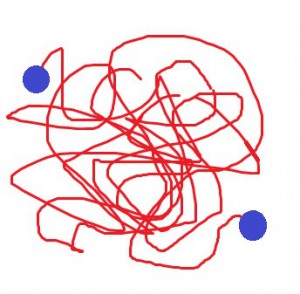The Most Important Edit No One Talks About

photo credit: Alaska mountains via photopin (license)
Everyone knows what I call the 10,000 foot edit – it’s the content/developmental edit – it’s looking at your story from a plane, to spot the plot mountains and canyons that need to be fixed. Genre no-no’s? Unsatisfying ending? That night with the weasel scene?
Everyone knows about ground level edits – copy/line/stylistic edits that look at sentence structure and grammar – they’re small, but important.

photo credit: parallel lines via photopin (license)
We all know those two edits are critical.
But there’s another edit that is very seldom talked about, that could take your manuscript from good to sold.
I call it the 5,000 foot edit. It’s the edit for EMOTION. I don’t care if you’re writing a romance or a legal or espionage thriller; if you don’t have a solid bedrock of emotion in your book, you’re not going to have readers. It’s what they come for! Think of your favorite author. Why is he your favorite? I’ll bet right up there with plot, is the emotion. If we don’t have emotion, the reader won’t care about your character. And that’s a story-killer.
Have I convinced you? Okay, let’s move on to how to do this thing.
In a book, regardless of genre, the character has to grow, right? So you need to follow the character’s arc, and be sure it happens in a timely, logical fashion. It’s okay if the character grows in fits and starts, or even if they progress, then back up a few steps. As long as their character arc doesn’t look like this:
A problem I’ve seen (and had) is that the character seems bipolar, going from laughing to angry to loving in three paragraphs. For emotion to be satisfying, it has to be deep. Take those three paragraphs, and dig deeper. It doesn’t mean you have to turn three paragraphs into three pages – sometimes a visceral hit and a one sentence reminder of the emotion will do:
This is from my RITA winner, The Sweet Spot:
The red flowers had some brown edges, and looked a bit bug-eaten. She’d planned to stop at Wal-Mart and pick up a bouquet on the way to the cemetery, but . . . Her stomach settled a bit. “These are Benje’s flowers. He’s not going to care about a few bugs.” She headed for the tool shed, to find her clippers.
I added a sentence of dialog that added emotion – a reminder to the reader of an emotional memory: working in the garden with her child (the child she’s going to visit in the cemetery). See?
No matter what genre you’re writing, not all scenes are action. If they are, you’re going to wear out your reader in no time. It’ll be a fast read, but also, unsatisfying, because in action, you can only show flashes of emotion – like paint splattered on a canvas, rather that brush-stroked on. You need what Dwight Swain, in his book, Techniques of the Selling Writer (a ‘must have’ on your craft shelf, IMHO) calls a ‘sequel scene’.
A quiet scene, where the POV character can reflect on what just happened, and compare the results to his world-view. These are the scenes that move him along his growth arc. You can only do that by getting deep into the emotion – because that character’s flaws in his world-view usually come from damage in his childhood: abuse, neglect, or even over-indulgence (poor little rich kid). And that’s emotional. Be sure you’re plumbing all that good stuff.
Ease into the sequel scene, naturally. You do this all the time, in your own head. This is from a Women’s Fiction my agent is shopping now:
And yet, nothing had been different last night than the zillions of other times she sat in a group, alone.
Except maybe her.
I’ll leave you with a Donald Maass-type (more must-have books for your craft shelf) homework lesson of where to edit for emotion :
- Find 5 turning point scenes. Laser focus the emotion. Go deeper.
- Find 5 small, quiet scenes. Laser focus the language.
- Use turning point scenes to plot a graph for your protagonist, showing their progression on their growth arc – is it logical?
- First line/page – better be the best work you’re capable of.
- The End – make it satisfying, using all the above.
So, have I convinced you to use my 5,000 foot edit? Do you have any edits strategies to share?